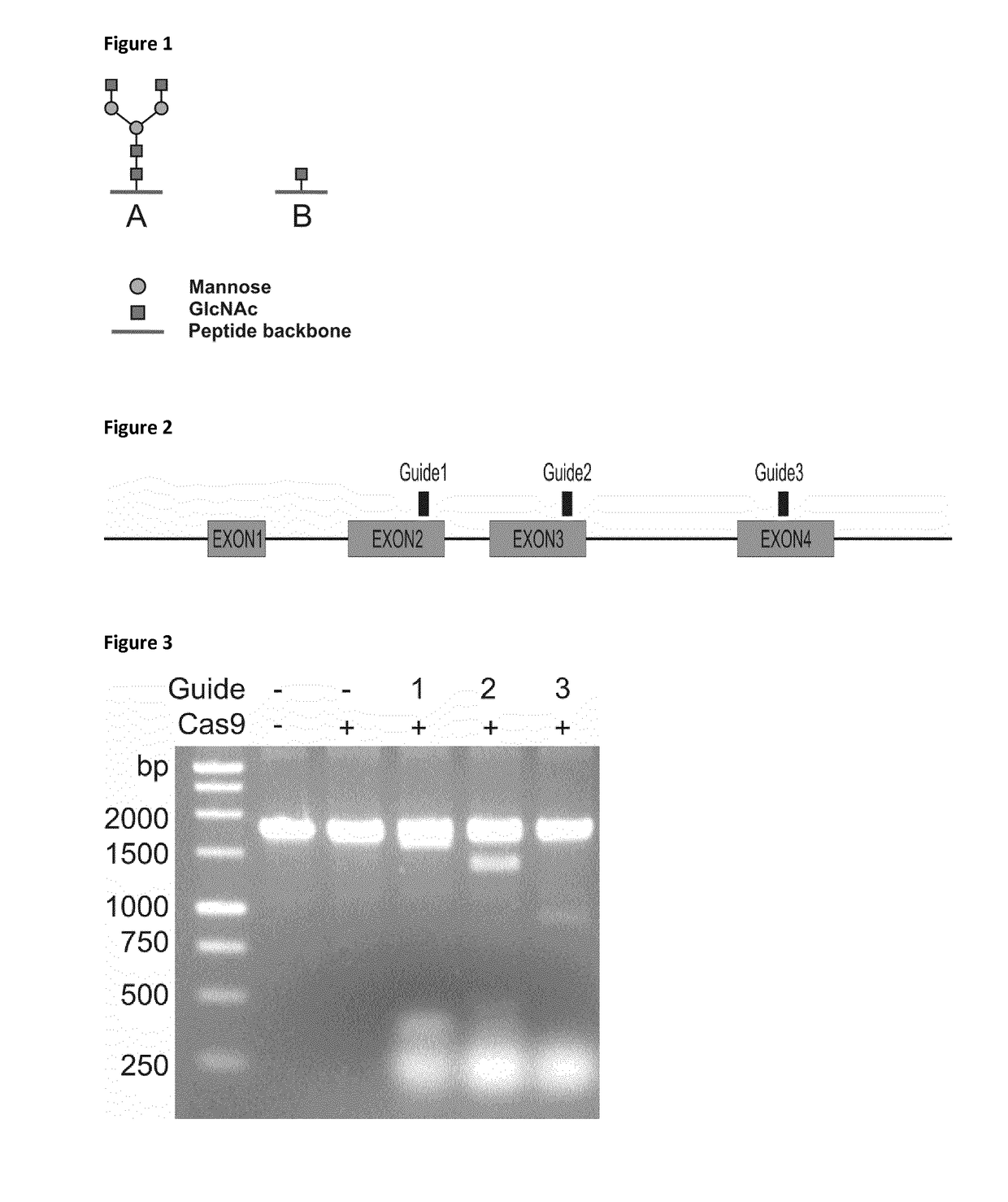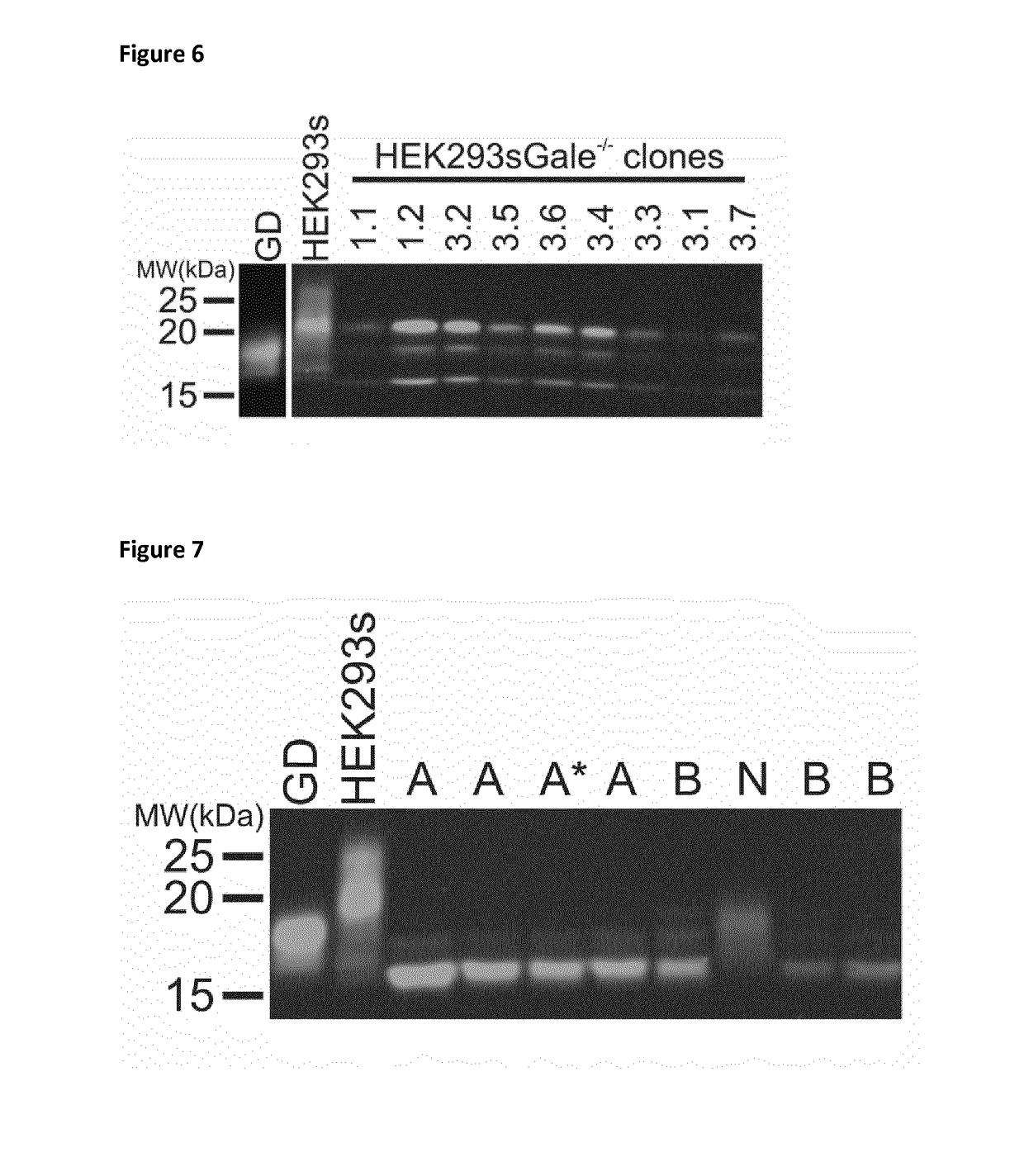Cells producing glycoproteins having altered n- and o-glycosylation patterns and methods and use thereof
a glycoprotein and cell technology, applied in the field of glycoengineering, can solve the problems of difficult to achieve the desired glycosylation pattern on a recombinantly produced protein, the heterogeneity of glycosylation remains an issue, and the heterogeneity of glycosylation remains a major problem, so as to remove the undesired glycosylation products, the effect of economic cost and tim
- Summary
- Abstract
- Description
- Claims
- Application Information
AI Technical Summary
Benefits of technology
Problems solved by technology
Method used
Image
Examples
example 1
n of a HEK293S Glycodelete Cell Line
[0124]This was done as described in WO 2010 / 015722 and Meuris et al. (Nat. Biotechnol. 2014 32(5):485-9).
[0125]Briefly, to avoid in vitro deglycosylation we implement in vivo de-N-glycosylation in a HEK293S cell-line. Identification and cloning of a fungal gene (Genbank Acc. No. CS423050) that encodes an endoH-type endoglycosidase, denoted as endoT because it was cloned from the filamentous fungi Trichoderma reesei (PhD thesis Ingeborg Stals, Ghent University, 2004) allows us to do so. The work is carried out in a glucosaminyltransferase I negative HEK cell-line, (Reeves, Callewaert et al., PNAS 99 (2002): 13419-13424). This cell-line almost exclusively produces Man5GlcNAc2—N-glycans, which are hydrolyzed in the chitobiose bond by endoH-type endoglycosidases.
[0126]EndoT is secreted by T. reesei (now designated as Hypocrea jecorina), which is indicative for the fact that it is adapted to folding in the eukaryotic secretion pathway. In order not to ...
example 2
e-N-Glycosylation of Glycoproteins by Targeting of the Fungal endoT Enzyme to the Secretory Pathway of Eukaryotic Organisms
[0134]Transient Transfection of endoT Constructs in Mammalian Cells
[0135]pCAGGS-hST-endoT, pCAGGS-hST-endoT-myc, pCAGGS-hGalNAcT-endoT and pCAGGS-hGalNAcT-endoT-myc were produced as described in WO 2010 / 015722 and Meuris et al. (Nat. Biotechnol. 2014 32(5):485-9). These plasmids and also the empty pCAGGS plasmid were used to transiently transfect the Hek293 S-Flt3 cell-line. As a negative control, the cells were also transfected without DNA. Cells were seeded at 200.000 cells per well in a six-well plate two days prior to transfection so that they are at least 85%-90% confluent at the day of transfection. Six hours prior to transfection, half of the medium was replaced by serum free medium and three hours prior to transfection, all medium (3 mL) was replaced by 2 mL of serum-free medium. DNA lipoplexes were prepared by combining 4 μg of plasmid DNA with L of lip...
example 3
n of a GlycoDoubleDelete Cell Line
Strategy
[0152]Our aim is to generate a cell line completely devoid of mucin type O-glycosylation. Combining this cell line with GlycoDelete engineering would then result in a “GlycoDoubleDelete” cell line, with both O- and N-glycan heterogeneity significantly reduced. These cell lines would be useful to produce glycoproteins that require their N-glycans to mediate correct folding, but do not require a fully matured N- or O-glycan to function. For example, in crystallography, glycan heterogeneity can hamper crystal formation. In addition glycans are known to influence the efficacy, activity and stability of biopharmaceuticals, but glycan heterogeneity can vary from batch to batch, which implicates that the properties of the pharmaceutical protein can vary equally.
[0153]An enzymatic strategy similar to the one used in GlycoDelete cells is impossible for O-glycans. In GlycoDelete cells, the endoT enzyme recognizes all N-glycans that are synthesized. Fo...
PUM
| Property | Measurement | Unit |
|---|---|---|
| Fraction | aaaaa | aaaaa |
| Fraction | aaaaa | aaaaa |
| Fraction | aaaaa | aaaaa |
Abstract
Description
Claims
Application Information
 Login to View More
Login to View More - R&D
- Intellectual Property
- Life Sciences
- Materials
- Tech Scout
- Unparalleled Data Quality
- Higher Quality Content
- 60% Fewer Hallucinations
Browse by: Latest US Patents, China's latest patents, Technical Efficacy Thesaurus, Application Domain, Technology Topic, Popular Technical Reports.
© 2025 PatSnap. All rights reserved.Legal|Privacy policy|Modern Slavery Act Transparency Statement|Sitemap|About US| Contact US: help@patsnap.com



